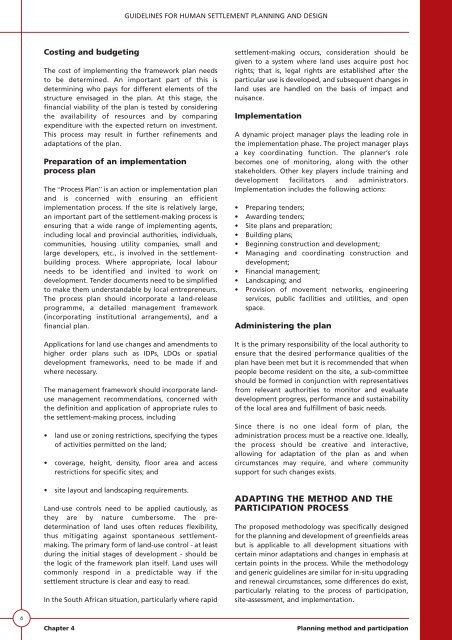VOLUME 1 HUMAN SETTLEMENT PLANNING AND ... - CSIR
VOLUME 1 HUMAN SETTLEMENT PLANNING AND ... - CSIR
VOLUME 1 HUMAN SETTLEMENT PLANNING AND ... - CSIR
- No tags were found...
You also want an ePaper? Increase the reach of your titles
YUMPU automatically turns print PDFs into web optimized ePapers that Google loves.
GUIDELINES FOR <strong>HUMAN</strong> <strong>SETTLEMENT</strong> <strong>PLANNING</strong> <strong>AND</strong> DESIGNCosting and budgetingThe cost of implementing the framework plan needsto be determined. An important part of this isdetermining who pays for different elements of thestructure envisaged in the plan. At this stage, thefinancial viability of the plan is tested by consideringthe availability of resources and by comparingexpenditure with the expected return on investment.This process may result in further refinements andadaptations of the plan.Preparation of an implementationprocess planThe “Process Plan” is an action or implementation planand is concerned with ensuring an efficientimplementation process. If the site is relatively large,an important part of the settlement-making process isensuring that a wide range of implementing agents,including local and provincial authorities, individuals,communities, housing utility companies, small andlarge developers, etc., is involved in the settlementbuildingprocess. Where appropriate, local labourneeds to be identified and invited to work ondevelopment. Tender documents need to be simplifiedto make them understandable by local entrepreneurs.The process plan should incorporate a land-releaseprogramme, a detailed management framework(incorporating institutional arrangements), and afinancial plan.Applications for land use changes and amendments tohigher order plans such as IDPs, LDOs or spatialdevelopment frameworks, need to be made if andwhere necessary.The management framework should incorporate landusemanagement recommendations, concerned withthe definition and application of appropriate rules tothe settlement-making process, including• land use or zoning restrictions, specifying the typesof activities permitted on the land;• coverage, height, density, floor area and accessrestrictions for specific sites; and• site layout and landscaping requirements.Land-use controls need to be applied cautiously, asthey are by nature cumbersome. The predeterminationof land uses often reduces flexibility,thus mitigating against spontaneous settlementmaking.The primary form of land-use control - at leastduring the initial stages of development - should bethe logic of the framework plan itself. Land uses willcommonly respond in a predictable way if thesettlement structure is clear and easy to read.In the South African situation, particularly where rapidsettlement-making occurs, consideration should begiven to a system where land uses acquire post hocrights; that is, legal rights are established after theparticular use is developed, and subsequent changes inland uses are handled on the basis of impact andnuisance.ImplementationA dynamic project manager plays the leading role inthe implementation phase. The project manager playsa key coordinating function. The planner’s rolebecomes one of monitoring, along with the otherstakeholders. Other key players include training anddevelopment facilitators and administrators.Implementation includes the following actions:• Preparing tenders;• Awarding tenders;• Site plans and preparation;• Building plans;• Beginning construction and development;• Managing and coordinating construction anddevelopment;• Financial management;• Landscaping; and• Provision of movement networks, engineeringservices, public facilities and utilities, and openspace.Administering the planIt is the primary responsibility of the local authority toensure that the desired performance qualities of theplan have been met but it is recommended that whenpeople become resident on the site, a sub-committeeshould be formed in conjunction with representativesfrom relevant authorities to monitor and evaluatedevelopment progress, performance and sustainabilityof the local area and fulfillment of basic needs.Since there is no one ideal form of plan, theadministration process must be a reactive one. Ideally,the process should be creative and interactive,allowing for adaptation of the plan as and whencircumstances may require, and where communitysupport for such changes exists.ADAPTING THE METHOD <strong>AND</strong> THEPARTICIPATION PROCESSThe proposed methodology was specifically designedfor the planning and development of greenfields areasbut is applicable to all development situations withcertain minor adaptations and changes in emphasis atcertain points in the process. While the methodologyand generic guidelines are similar for in-situ upgradingand renewal circumstances, some differences do exist,particularly relating to the process of participation,site-assessment, and implementation.6Chapter 4Planning method and participation
















